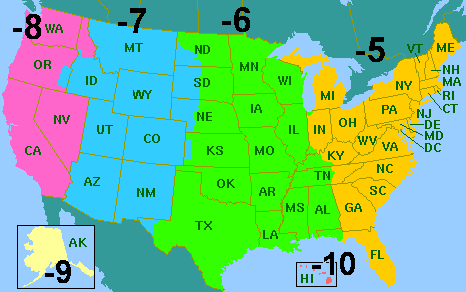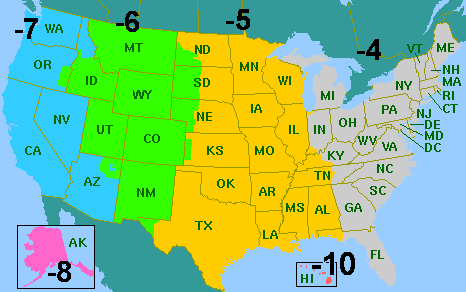Last update:
5-Aug-2006
©1996-2007
Mike Todd
![]()
Daylight Saving Time
|
March 2007 - warning!! |
The
basic zones
The US is large enough to have actually have eight time zones legally
defined. The six that most people know are the four across the contiguous
48 states, Alaska and Hawaii. However, there is a seventh time zone designated
the Samoa Zone, and an eighth, the Atlantic Zone.
The map below shows the main six zones. It's a bit surprising to see that the time-zone boundaries don't follow state boundaries, and some states have two time zones in them.
|
Pacific
Standard
|
Mountain
Standard
|
Central
Standard
|
Eastern
Standard
|
 |
|||
| Alaskan Standard |
Hawaii-Aleutian
|
||
Daylight
Saving Time
Like many countries
in the world, the US changes its clocks by an hour in the spring and autumn.
It was originally suggested back in 1784, by Benjamin Fanklin, and was
adopted by the British in 1911 (for further details, see The
history of British Summer Time)
It was first introduced in the US on March 31st, 1918 by Woodrow Wilson to help the war effort by cutting the demand for electricity. The clocks went back in October of that year, but in 1919 Congress repealed the federal mandate that required all states to observe it. Wilson tried to veto the repeal, but failed. Despite this, many states decided they would continue with Daylight Saving Time, with each state deciding when it would start and stop. The situation soon became chaotic.
It took until 1966, when the Universal Time Act was introduced, before start and end times were standardised across the US. Daylight Saving Time would start at 2am on the last Sunday in April and end at 2am on the last Sunday in October.
In 1986, Congress moved the start of Daylight Saving Time to the first Sunday in April, although standard time continued to be restored on the last Sunday in October. This means that it starts a week later than it does in the UK (so for one week, the difference between US and UK time is an hour less), but returning to standard time occurs on the same day.
However, from 2007 (under the Energy Policy Act of 2005) American Daylight Saving Time will start three weeks earlier, and end a week later, in a bid to save energy. In 2007, Daylight Saving Time will start on the second Sunday of March and end on the first Sunday of November. But this is only a trial, and the Energy Policy Act states that a report must be submitted to Congress within 9 months and that, in the Right to Revert clause, Congress retains the right to revert to the previous schedules once this study has been completed.
Even though Congress decrees the existence of Daylight Saving Time, states are free to ignore it if they so choose. There are two states where this is the case:
Arizona: The Navajo reservation observes DST, but the remainder of the state stays on standard time. The Navajo reservation has the Hopi reservation in the middle, so there's a bit of a mixture of the two time zones in the north-east of the state.
Hawaii: does not observe DST at all
However, until very recently, Indiana was a state apart. Not only does the state cut across two time zones, some counties chose to observe DST while others chose not to which, in effect, meant that Indiana had three different "time zones". Since 2006, the entire state of Indiana now observes DST, although 18 counties remain on Central Time and the other 74 are on Eastern Time.
The map shows the effect of Daylight Saving Time on GMT (BST will be one hour more, so that "-4" will be "-5")
|
Pacific
Daylight
|
Mountain
Daylight
|
Central
Daylight
|
Eastern
Daylight
|
 |
|||
| Alaskan Daylight |
Hawaii-Aleutian
|
||